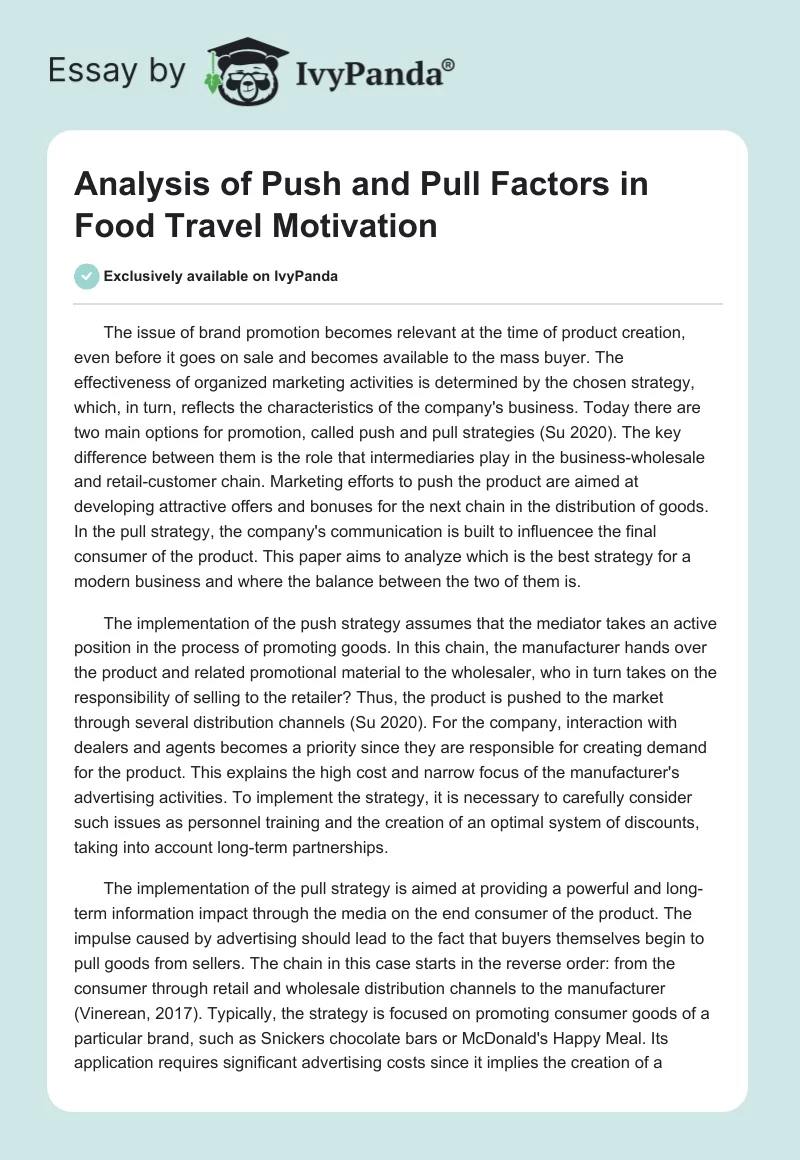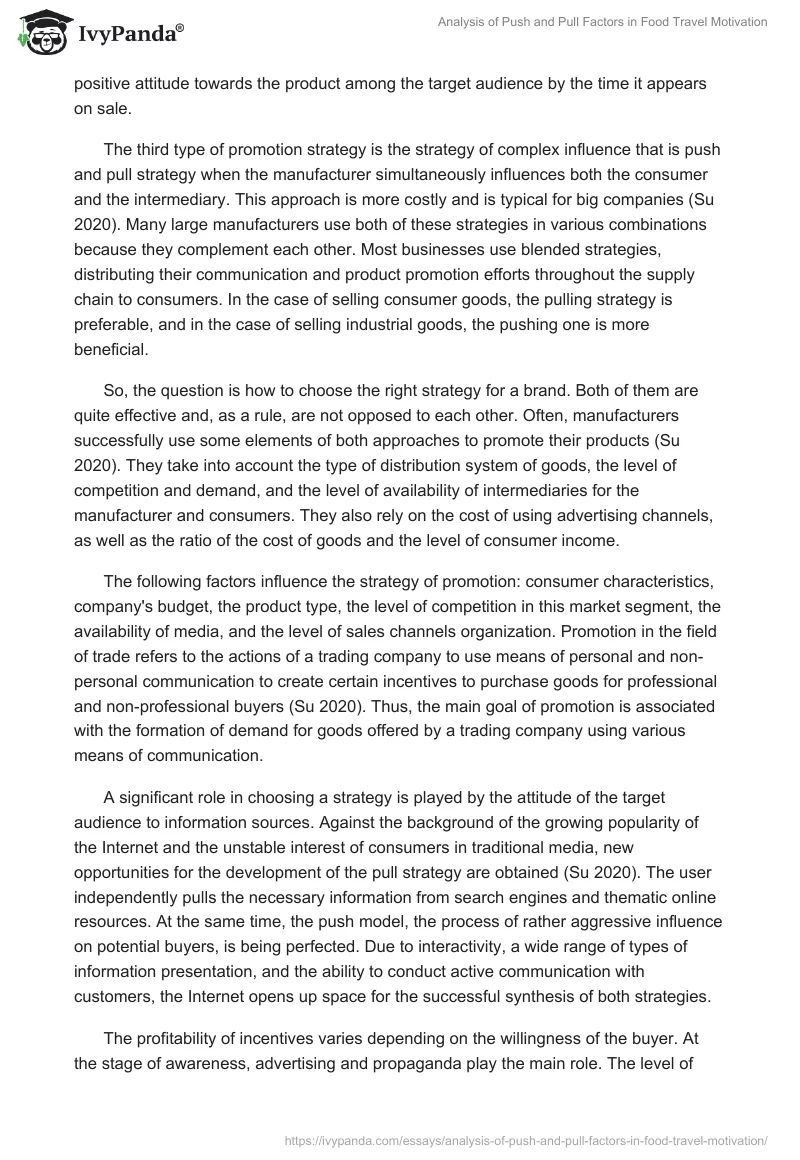The issue of brand promotion becomes relevant at the time of product creation, even before it goes on sale and becomes available to the mass buyer. The effectiveness of organized marketing activities is determined by the chosen strategy, which, in turn, reflects the characteristics of the company’s business. Today there are two main options for promotion, called push and pull strategies (Su 2020). The key difference between them is the role that intermediaries play in the business-wholesale and retail-customer chain. Marketing efforts to push the product are aimed at developing attractive offers and bonuses for the next chain in the distribution of goods. In the pull strategy, the company’s communication is built to influencee the final consumer of the product. This paper aims to analyze which is the best strategy for a modern business and where the balance between the two of them is.
The implementation of the push strategy assumes that the mediator takes an active position in the process of promoting goods. In this chain, the manufacturer hands over the product and related promotional material to the wholesaler, who in turn takes on the responsibility of selling to the retailer? Thus, the product is pushed to the market through several distribution channels (Su 2020). For the company, interaction with dealers and agents becomes a priority since they are responsible for creating demand for the product. This explains the high cost and narrow focus of the manufacturer’s advertising activities. To implement the strategy, it is necessary to carefully consider such issues as personnel training and the creation of an optimal system of discounts, taking into account long-term partnerships.
The implementation of the pull strategy is aimed at providing a powerful and long-term information impact through the media on the end consumer of the product. The impulse caused by advertising should lead to the fact that buyers themselves begin to pull goods from sellers. The chain in this case starts in the reverse order: from the consumer through retail and wholesale distribution channels to the manufacturer (Vinerean, 2017). Typically, the strategy is focused on promoting consumer goods of a particular brand, such as Snickers chocolate bars or McDonald’s Happy Meal. Its application requires significant advertising costs since it implies the creation of a positive attitude towards the product among the target audience by the time it appears on sale.
The third type of promotion strategy is the strategy of complex influence that is push and pull strategy when the manufacturer simultaneously influences both the consumer and the intermediary. This approach is more costly and is typical for big companies (Su 2020). Many large manufacturers use both of these strategies in various combinations because they complement each other. Most businesses use blended strategies, distributing their communication and product promotion efforts throughout the supply chain to consumers. In the case of selling consumer goods, the pulling strategy is preferable, and in the case of selling industrial goods, the pushing one is more beneficial.
So, the question is how to choose the right strategy for a brand. Both of them are quite effective and, as a rule, are not opposed to each other. Often, manufacturers successfully use some elements of both approaches to promote their products (Su 2020). They take into account the type of distribution system of goods, the level of competition and demand, and the level of availability of intermediaries for the manufacturer and consumers. They also rely on the cost of using advertising channels, as well as the ratio of the cost of goods and the level of consumer income.
The following factors influence the strategy of promotion: consumer characteristics, company’s budget, the product type, the level of competition in this market segment, the availability of media, and the level of sales channels organization. Promotion in the field of trade refers to the actions of a trading company to use means of personal and non-personal communication to create certain incentives to purchase goods for professional and non-professional buyers (Su 2020). Thus, the main goal of promotion is associated with the formation of demand for goods offered by a trading company using various means of communication.
A significant role in choosing a strategy is played by the attitude of the target audience to information sources. Against the background of the growing popularity of the Internet and the unstable interest of consumers in traditional media, new opportunities for the development of the pull strategy are obtained (Su 2020). The user independently pulls the necessary information from search engines and thematic online resources. At the same time, the push model, the process of rather aggressive influence on potential buyers, is being perfected. Due to interactivity, a wide range of types of information presentation, and the ability to conduct active communication with customers, the Internet opens up space for the successful synthesis of both strategies.
The profitability of incentives varies depending on the willingness of the buyer. At the stage of awareness, advertising and propaganda play the main role. The level of education most of all influences the knowledge of the consumer, and advertising and personal selling play a supporting role (Su 2020). Consumer confidence is primarily influenced by personal selling techniques and slightly less by advertising. Completion of the transaction is primarily the function of personal selling.
Taking into account the stages of the product’s life cycle is of great importance for choosing a strategy. Advertising and propaganda are the most effective means at the stage of bringing a product to the market (Vinerean, 2017). This is understandable since the company needs to show the advantages of a new product firstso that an intrigued buyer starts asking for it in retail. During the growth phase, advertising and propaganda continue to serve as powerful engines while reducing promotional costs. At the maturity stage, sales promotion becomes important again since advertising should remind customers of the product. In the decline stage, advertising is used to remind and perhaps reposition an old brand. It is possible to extend the life of a product somewhat by sales promotion.
However, the effect of sales promotion is short-lived and is not suitable for creating a stable preference for the product. Moreover, a protracted sales promotion campaign can diminish the brand’s image in the eyes of buyers and create distrust for a product that has been on sale on preferential terms for so long (Vinerean, 2017). Therefore, in most cases, a combination of certain types of promotion is used since each of them performs different functions and therefore complements the others.
For example, advertisements target large audiences and inform them about the product. Without ads, personal sales are much more difficult, time-consuming, and expensive. Publicity provides reliable information to a wide audience, but its content and timing cannot be controlled by the company (Vinerean, 2017). Personal selling provides a personal contact, flexibility, and the ability to close deals. Without it, the initial interest generated by the advertisements will be lost. Sales promotion leads to short-term sales growth and complements advertising and sales.
The choice of strategy also depends on the size of the company. Not all types of advertising are available to small brands, so the most profitable for them is the use of personal sales. A large company working for a large region, on the contrary, may focus on advertising, while non-profit organizations are interested in maximizing publicity (Vinerean, 2017). Consumer goods companies tend to advertise their brands while manufacturers are intensifying their selling efforts. As the product moves through the life cycle, the emphasis in the incentive complex shifts from information to persuasion and confirmation. Accordingly, the combination of promotion types in the incentive complex changes.
So, the entry of a company into new markets, positioning or repositioning of goods on the market, and the formation of a certain image require various means of promotion. The combination of push and pull approaches is relevant not only for the online space. Practice shows that the best results today are achieved by the company that timely responds to the needs of the target audience and the changes taking place in the market. The competent use of elements of one or more strategies can be a decisive competitive advantage for a business.
References
Su, D. N., Johnson, L. W., & O’Mahony, B. (2020). Analysis of push and pull factors in food travel motivation. Current Issues in Tourism, 23(5), 572-586.
Vinerean, S. (2017). Content marketing strategy. Definition, objectives and tactics. Expert Journal of Marketing, 5(2), 92-98.


